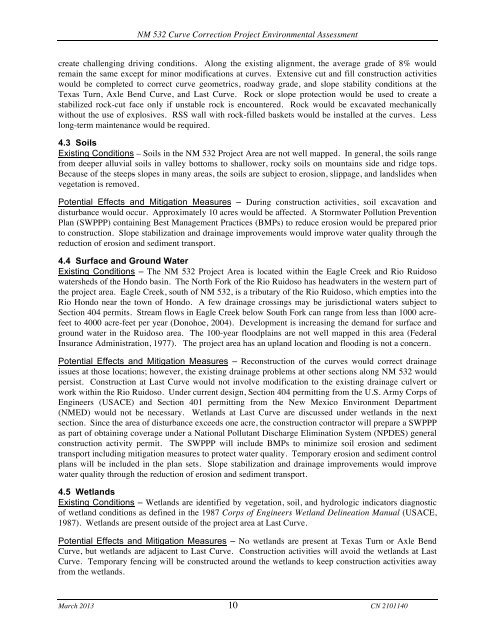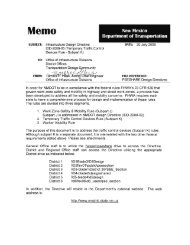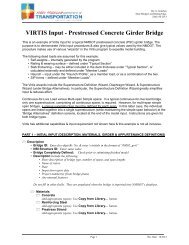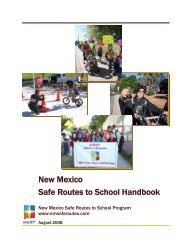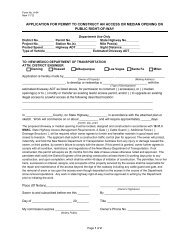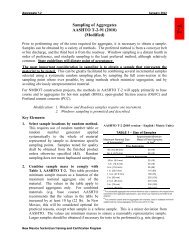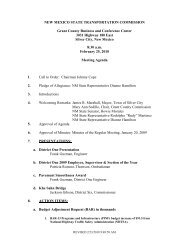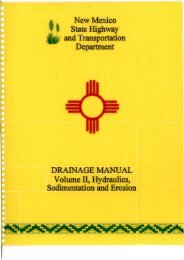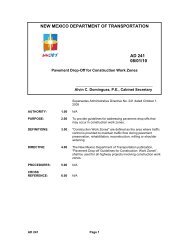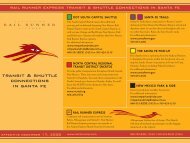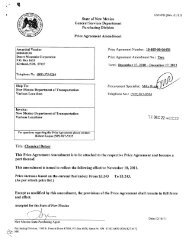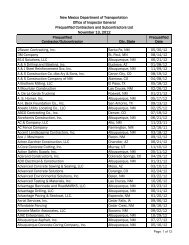NM 532 Curve Correction Project - New Mexico Department of ...
NM 532 Curve Correction Project - New Mexico Department of ...
NM 532 Curve Correction Project - New Mexico Department of ...
You also want an ePaper? Increase the reach of your titles
YUMPU automatically turns print PDFs into web optimized ePapers that Google loves.
<strong>NM</strong> <strong>532</strong> <strong>Curve</strong> <strong>Correction</strong> <strong>Project</strong> Environmental Assessment<br />
create challenging driving conditions. Along the existing alignment, the average grade <strong>of</strong> 8% would<br />
remain the same except for minor modifications at curves. Extensive cut and fill construction activities<br />
would be completed to correct curve geometrics, roadway grade, and slope stability conditions at the<br />
Texas Turn, Axle Bend <strong>Curve</strong>, and Last <strong>Curve</strong>. Rock or slope protection would be used to create a<br />
stabilized rock-cut face only if unstable rock is encountered. Rock would be excavated mechanically<br />
without the use <strong>of</strong> explosives. RSS wall with rock-filled baskets would be installed at the curves. Less<br />
long-term maintenance would be required.<br />
4.3 Soils<br />
Existing Conditions – Soils in the <strong>NM</strong> <strong>532</strong> <strong>Project</strong> Area are not well mapped. In general, the soils range<br />
from deeper alluvial soils in valley bottoms to shallower, rocky soils on mountains side and ridge tops.<br />
Because <strong>of</strong> the steeps slopes in many areas, the soils are subject to erosion, slippage, and landslides when<br />
vegetation is removed.<br />
Potential Effects and Mitigation Measures – During construction activities, soil excavation and<br />
disturbance would occur. Approximately 10 acres would be affected. A Stormwater Pollution Prevention<br />
Plan (SWPPP) containing Best Management Practices (BMPs) to reduce erosion would be prepared prior<br />
to construction. Slope stabilization and drainage improvements would improve water quality through the<br />
reduction <strong>of</strong> erosion and sediment transport.<br />
4.4 Surface and Ground Water<br />
Existing Conditions – The <strong>NM</strong> <strong>532</strong> <strong>Project</strong> Area is located within the Eagle Creek and Rio Ruidoso<br />
watersheds <strong>of</strong> the Hondo basin. The North Fork <strong>of</strong> the Rio Ruidoso has headwaters in the western part <strong>of</strong><br />
the project area. Eagle Creek, south <strong>of</strong> <strong>NM</strong> <strong>532</strong>, is a tributary <strong>of</strong> the Rio Ruidoso, which empties into the<br />
Rio Hondo near the town <strong>of</strong> Hondo. A few drainage crossings may be jurisdictional waters subject to<br />
Section 404 permits. Stream flows in Eagle Creek below South Fork can range from less than 1000 acrefeet<br />
to 4000 acre-feet per year (Donohoe, 2004). Development is increasing the demand for surface and<br />
ground water in the Ruidoso area. The 100-year floodplains are not well mapped in this area (Federal<br />
Insurance Administration, 1977). The project area has an upland location and flooding is not a concern.<br />
Potential Effects and Mitigation Measures – Reconstruction <strong>of</strong> the curves would correct drainage<br />
issues at those locations; however, the existing drainage problems at other sections along <strong>NM</strong> <strong>532</strong> would<br />
persist. Construction at Last <strong>Curve</strong> would not involve modification to the existing drainage culvert or<br />
work within the Rio Ruidoso. Under current design, Section 404 permitting from the U.S. Army Corps <strong>of</strong><br />
Engineers (USACE) and Section 401 permitting from the <strong>New</strong> <strong>Mexico</strong> Environment <strong>Department</strong><br />
(<strong>NM</strong>ED) would not be necessary. Wetlands at Last <strong>Curve</strong> are discussed under wetlands in the next<br />
section. Since the area <strong>of</strong> disturbance exceeds one acre, the construction contractor will prepare a SWPPP<br />
as part <strong>of</strong> obtaining coverage under a National Pollutant Discharge Elimination System (NPDES) general<br />
construction activity permit. The SWPPP will include BMPs to minimize soil erosion and sediment<br />
transport including mitigation measures to protect water quality. Temporary erosion and sediment control<br />
plans will be included in the plan sets. Slope stabilization and drainage improvements would improve<br />
water quality through the reduction <strong>of</strong> erosion and sediment transport.<br />
4.5 Wetlands<br />
Existing Conditions – Wetlands are identified by vegetation, soil, and hydrologic indicators diagnostic<br />
<strong>of</strong> wetland conditions as defined in the 1987 Corps <strong>of</strong> Engineers Wetland Delineation Manual (USACE,<br />
1987). Wetlands are present outside <strong>of</strong> the project area at Last <strong>Curve</strong>.<br />
Potential Effects and Mitigation Measures – No wetlands are present at Texas Turn or Axle Bend<br />
<strong>Curve</strong>, but wetlands are adjacent to Last <strong>Curve</strong>. Construction activities will avoid the wetlands at Last<br />
<strong>Curve</strong>. Temporary fencing will be constructed around the wetlands to keep construction activities away<br />
from the wetlands.<br />
March 2013 10 CN 2101140


